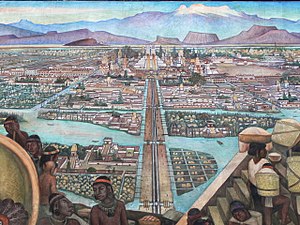
Back الجداريات المكسيكية Arabic Meksika monumental boyakarlığı Azerbaijani মেক্সিকান মুর্যালবাদ Bengali/Bangla Muralisme mexicà Catalan Muralismus Czech Muralismo Danish Muralismo German Muralismo mexicano Spanish Muralismo Estonian Mexikar muralismo Basque

Mexican muralism refers to the art project initially funded by the Mexican government in the immediate wake of the Mexican Revolution (1910–1920) to depict visions of Mexico's past, present, and future, transforming the walls of many public buildings into didactic scenes designed to reshape Mexicans' understanding of the nation's history. The murals, large artworks painted onto the walls themselves had social, political, and historical messages. Beginning in the 1920s, the muralist project was headed by a group of artists known as "The Big Three" or "The Three Greats".[1] This group was composed of Diego Rivera, José Clemente Orozco and David Alfaro Siqueiros. Although not as prominent as the Big Three, women also created murals in Mexico. From the 1920s to the 1970s, murals with nationalistic, social and political messages were created in many public settings such as chapels, schools, government buildings, and much more. The popularity of the Mexican muralist project started a tradition which continues to this day in Mexico; a tradition that has had a significant impact in other parts of the Americas, including the United States, where it served as inspiration for the Chicano art movement.
- ^ "Mexican Muralism". Art History Teaching Resources. 2014-09-26. Retrieved 2021-11-19.